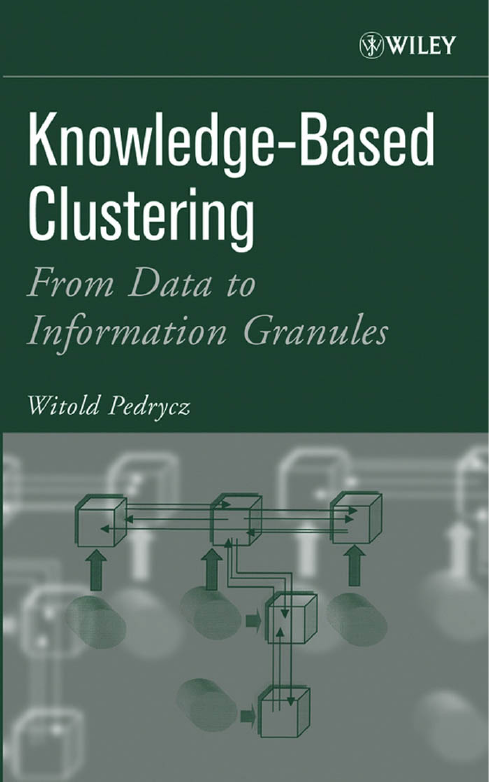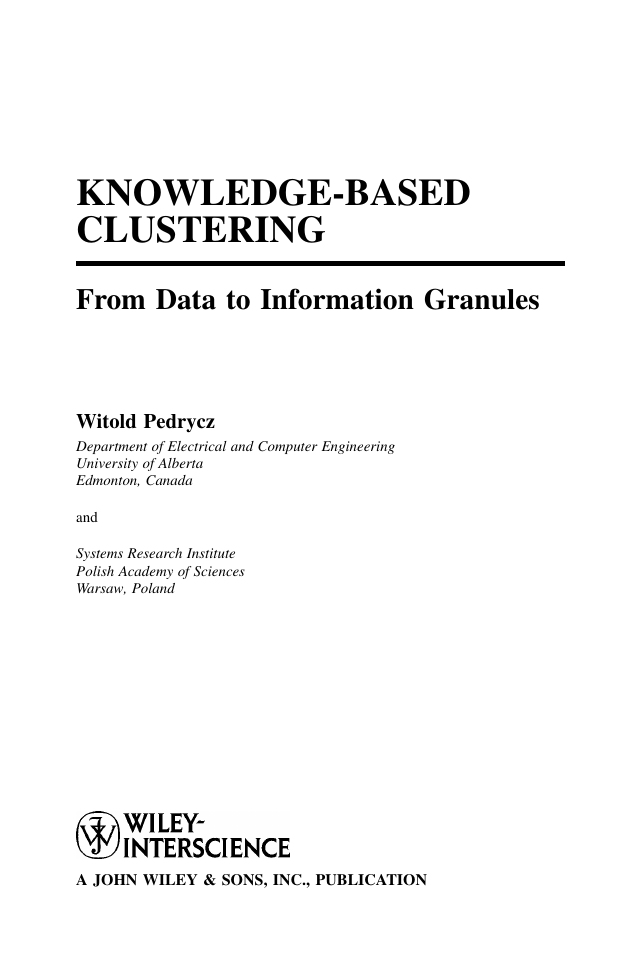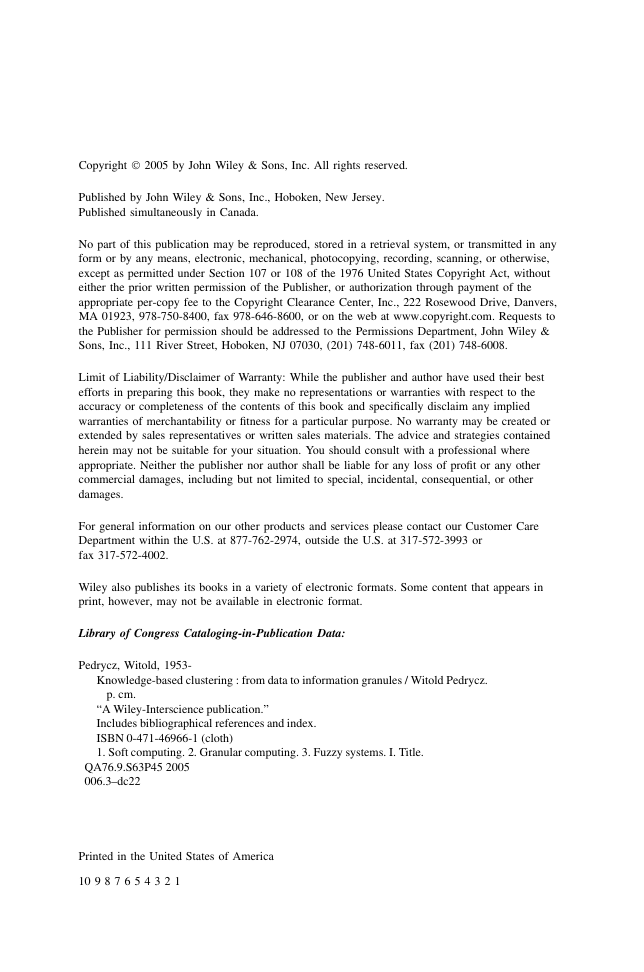Cover
Contents
Foreword
Preface
Clustering and Fuzzy Clustering
1.1. INTRODUCTION
1.2. BASIC NOTIONS AND NOTATION
1.2.1. Types of Data
1.2.2. Distance and Similarity
1.3. MAIN CATEGORIES OF CLUSTERING ALGORITHMS
1.3.1. Hierarchical Clustering
1.3.2. Objective Function-Based Clustering
1.4. CLUSTERING AND CLASSIFICATION
1.5. FUZZY CLUSTERING
1.6. CLUSTER VALIDITY
1.7. EXTENSIONS OF OBJECTIVE FUNCTION-BASED
1.7.1. Augmented Geometry of Fuzzy Clusters: Fuzzy C Varieties
1.7.2. Possibilistic Clustering
1.7.3. Noise Clustering
1.8. SELF-ORGANIZING MAPS AND FUZZY OBJECTIVE
1.9. CONCLUSIONS
Logic-Oriented Neurocomputing
3.1. INTRODUCTION
3.2. MAIN CATEGORIES OF FUZZY NEURONS
3.2.1. Aggregative Neurons
3.2.2. Referential (Reference) Neurons
3.3. ARCHITECTURES OF LOGIC NETWORKS
3.4. INTERPRETATION ASPECTS OF THE NETWORKS
3.5. GRANULAR INTERFACES OF LOGIC PROCESSING
3.6. CONCLUSIONS
Conditional Fuzzy Clustering
4.1. INTRODUCTION
4.2. PROBLEM STATEMENT: CONTEXT FUZZY SETS
4.3. THE OPTIMIZATION PROBLEM
4.4. COMPUTATIONAL CONSIDERATIONS
4.5. GENERALIZATIONS OF THE ALGORITHM THROUGH
4.6. FUZZY CLUSTERING WITH SPATIAL CONSTRAINTS
4.7. CONCLUSIONS
Principles of Knowledge-Based Guidance in Fuzzy Clustering
6.1. INTRODUCTION
6.2. EXAMPLES OF KNOWLEDGE-ORIENTED HINTS
6.3. THE OPTIMIZATION ENVIRONMENT
6.4. QUANTIFICATION OF KNOWLEDGE-BASED GUIDANCE HINTS
6.5. ORGANIZATION OF THE INTERACTION PROCESS
6.6. PROXIMITY-BASED CLUSTERING (P-FCM)
6.7. WEB EXPLORATION AND P-FCM
6.8. LINGUISTIC AUGMENTATION OF KNOWLEDGE-BASED HINTS
6.9. CONCLUSIONS
Collaborative Clustering
7.1. INTRODUCTION AND RATIONALE
7.2. HORIZONTAL AND VERTICAL CLUSTERING
7.3. HORIZONTAL COLLABORATIVE CLUSTERING
7.3.1. Optimization Details
7.3.2. The Flow of Computing of Collaborative Clustering
7.3.3. Quantification of the Collaborative Phenomenon of Clustering
7.4. EXPERIMENTAL STUDIES
7.5. FURTHER ENHANCEMENTS OF HORIZONTAL CLUSTERING
7.6. THE ALGORITHM OF VERTICAL CLUSTERING
7.7. A GRID MODEL OF HORIZONTAL AND VERTICAL
7.8. CONSENSUS CLUSTERING
7.9. CONCLUSIONS
Directional Clustering
8.1. INTRODUCTION
8.2. PROBLEM FORMULATION
8.2.1. The Objective Function
8.2.2. The Logic Transformation Between Information Granules
8.3. THE ALGORITHM
8.4. THE DEVELOPMENT FRAMEWORK
8.5. NUMERICAL STUDIES
8.6. CONCLUSIONS
Fuzzy Relational Clustering
9.1. INTRODUCTION AND PROBLEM STATEMENT
9.2. FCM FOR RELATIONAL DATA
9.3. DECOMPOSITION OF FUZZY RELATIONAL PATTERNS
9.3.1. Gradient-Based Solution to the Decomposition Problem
9.3.2. Neural Network Model of the Decomposition Problem
9.4. COMPARATIVE ANALYSIS
9.5. CONCLUSIONS
Fuzzy Clustering of Heterogeneous Patterns
10.1. INTRODUCTION
10.2. HETEROGENEOUS DATA
10.3. PARAMETRIC MODELS OF GRANULAR DATA
10.4. PARAMETRIC MODE OF HETEROGENEOUS
10.5. NONPARAMETRIC HETEROGENEOUS CLUSTERING
10.5.1. A Frame of Reference
10.5.2. Representation of Granular Data Through the Possibility-Necessity
10.5.3. Dereferencing
10.6. CONCLUSIONS
Hyperbox Models of Granular Data: The Tchebyschev FCM
11.1. INTRODUCTION
11.2. PROBLEM FORMULATION
11.3. THE CLUSTERING ALGORITHM—DETAILED
11.4. DEVELOPMENT OF GRANULAR PROTOTYPES
11.5. GEOMETRY OF INFORMATION GRANULES
11.6. GRANULAR DATA DESCRIPTION: A GENERAL MODEL
11.7. CONCLUSIONS
Genetic Tolerance Fuzzy Neural Networks
12.1. INTRODUCTION
12.2. OPERATIONS OF THRESHOLDING AND TOLERANCE:
12.3. TOPOLOGY OF THE LOGIC NETWORK
12.4. GENETIC OPTIMIZATION
12.5. ILLUSTRATIVE NUMERIC STUDIES
12.6. CONCLUSIONS
Granular Prototyping
13.1. INTRODUCTION
13.2. PROBLEM FORMULATION
13.2.1. Expressing Similarity Between Two Fuzzy Sets
13.2.2. Performance Index (Objective Function)
13.3. PROTOTYPE OPTIMIZATION
13.4. DEVELOPMENT OF GRANULAR PROTOTYPES
13.4.1. Optimization of the Similarity Levels
13.4.2. An Inverse Similarity Problem
13.5. CONCLUSIONS
Granular Mappings
14.1. INTRODUCTION AND PROBLEM STATEMENT
14.2. POSSIBILITY AND NECESSITY MEASURES AS THE
14.3. BUILDING THE GRANULAR MAPPING
14.4. DESIGNING MULTIVARIABLE GRANULAR MAPPINGS
14.5. QUANTIFICATION OF GRANULAR MAPPINGS
14.6. EXPERIMENTAL STUDIES
14.7. CONCLUSIONS
Linguistic Modeling
15.1. INTRODUCTION
15.2. CLUSTER-BASED REPRESENTATION
15.3. CONDITIONAL CLUSTERING IN THE DEVELOPMENT
15.4. THE GRANULAR NEURON AS A GENERIC PROCESSING
15.5. THE ARCHITECTURE OF LINGUISTIC MODELS BASED
15.6. REFINEMENTS OF LINGUISTIC MODELS
15.7. CONCLUSIONS
Bibliography
Index
















 2023年江西萍乡中考道德与法治真题及答案.doc
2023年江西萍乡中考道德与法治真题及答案.doc 2012年重庆南川中考生物真题及答案.doc
2012年重庆南川中考生物真题及答案.doc 2013年江西师范大学地理学综合及文艺理论基础考研真题.doc
2013年江西师范大学地理学综合及文艺理论基础考研真题.doc 2020年四川甘孜小升初语文真题及答案I卷.doc
2020年四川甘孜小升初语文真题及答案I卷.doc 2020年注册岩土工程师专业基础考试真题及答案.doc
2020年注册岩土工程师专业基础考试真题及答案.doc 2023-2024学年福建省厦门市九年级上学期数学月考试题及答案.doc
2023-2024学年福建省厦门市九年级上学期数学月考试题及答案.doc 2021-2022学年辽宁省沈阳市大东区九年级上学期语文期末试题及答案.doc
2021-2022学年辽宁省沈阳市大东区九年级上学期语文期末试题及答案.doc 2022-2023学年北京东城区初三第一学期物理期末试卷及答案.doc
2022-2023学年北京东城区初三第一学期物理期末试卷及答案.doc 2018上半年江西教师资格初中地理学科知识与教学能力真题及答案.doc
2018上半年江西教师资格初中地理学科知识与教学能力真题及答案.doc 2012年河北国家公务员申论考试真题及答案-省级.doc
2012年河北国家公务员申论考试真题及答案-省级.doc 2020-2021学年江苏省扬州市江都区邵樊片九年级上学期数学第一次质量检测试题及答案.doc
2020-2021学年江苏省扬州市江都区邵樊片九年级上学期数学第一次质量检测试题及答案.doc 2022下半年黑龙江教师资格证中学综合素质真题及答案.doc
2022下半年黑龙江教师资格证中学综合素质真题及答案.doc